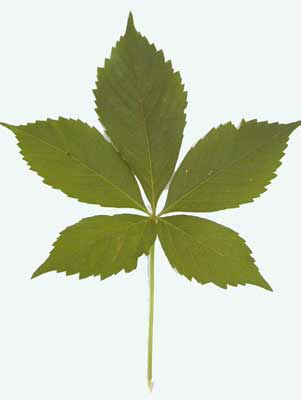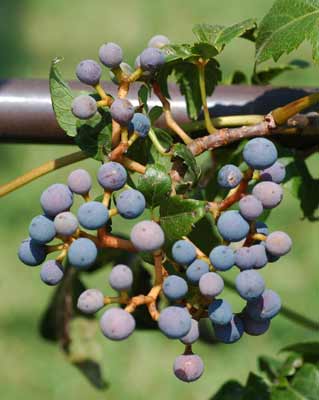Virginia Creeper
Common Name: Virginia Creeper
Species Name: Parthenocissus quinquefolia
Plant Type: Woody
Family Name: Vitaceae, Grape Family
Examples of Virginia CreeperParthenocissus quinquefolia
| Plant Facts | |
|---|---|
| Origin | Eastern half of North America and south to Mexico |
| Sun Preference | Full Sun |
| Duration | Perennial |
| Distribution in the U.S. | Eastern half as far west as southeastern South Dakota, eastern Nebraska, Kansas and Texas |
| Distribution in Oklahoma | Throughout the state |
ID Characteristics
- Field Identification Characteristics
Vegetative
- Readily recognized by “leaves of 5”; leaves serrated
- Climbing stems with branched tendrils
- Bright red foliage in fall
Floral
- Produces clusters of black to blue-black berries
- Leaf and Stem Characteristics
- Plant Height: 100-foot height
- Leaves: Alternate, palmately compound, 3-5 leaflets, elliptic to obovate-oblong, 1.5-4 inches long, 0.5-2.5 inches wide, coarsely
- Growth Form: Woody vines
- Leaf Type: Compound, palmately
- Leaf Arrangement: Alternate
- Leaf Blade Edge: Serrated
- Leaf Blade Length: 7-15 centimeters
- Floral Characteristics
- Petal Number: 4-5
- Flower Color: Green
- Flower Timing: May-June
- Fruit Type: Berries
| Habitat/Ecology | |
|---|---|
| Habitat | Attached to the trunks of trees and forming large masses of foliage in their crowns, forest edges and openings |
| Soil Preference | Moist, well-drained sand, loam, clay and rocky soil; adapted to most soil conditions |
| USDA Cold Hardiness Zone | 3 |
| Successional Stage | Mid to late |
| Notes | Fast growth rate; salt tolerant |
Topics:


